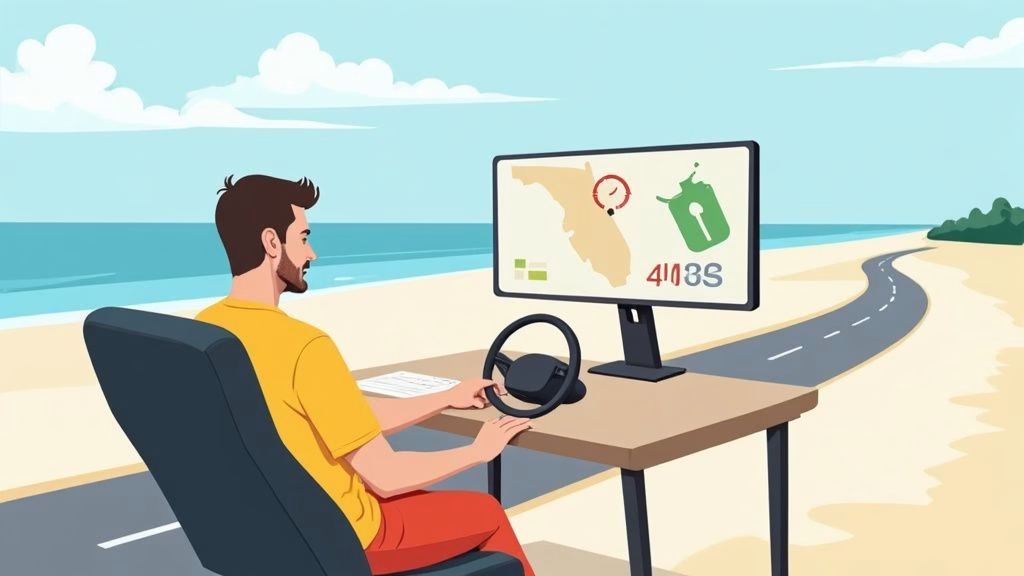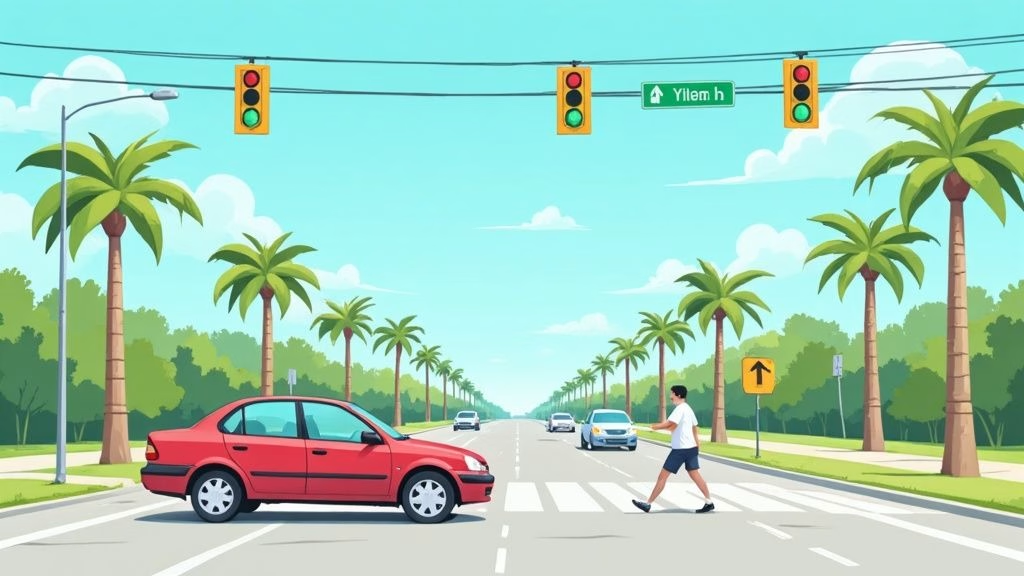Motor vehicle crashes claim over 38,000 lives annually in the United States, with human error accounting for 94% of serious traffic incidents according to the National Highway Traffic Safety Administration.
At floridanewdriver.com, we believe mastering defensive driving safety tips can dramatically reduce your risk on the road. These proven techniques help you anticipate dangers, react appropriately to hazards, and protect yourself from other drivers’ mistakes.
Essential Defensive Driving Techniques
Maintain Safe Following Distance
The three-second following distance rule forms the foundation of defensive driving, but most drivers maintain only 1.5 seconds according to the Insurance Institute for Highway Safety. Professional drivers use the four-second rule as their minimum standard and increase this to six seconds in adverse weather conditions. Count the seconds between when the vehicle ahead passes a fixed object and when your front bumper reaches the same point. This calculation method works at any speed and provides adequate reaction time to brake safely without rear-ending the vehicle ahead.
Scan the Road Environment Continuously
Effective road scanning requires you to check mirrors regularly and look ahead at least 12 seconds down the road. The National Safety Council reports that drivers who actively scan their environment reduce collision risk by 35% compared to those who focus only on the vehicle directly ahead. Check your rearview mirror before you brake, scan intersections completely before you proceed on green lights, and monitor blind spots before you change lanes. Weather conditions demand increased scanning frequency (particularly when visibility drops below 500 feet).
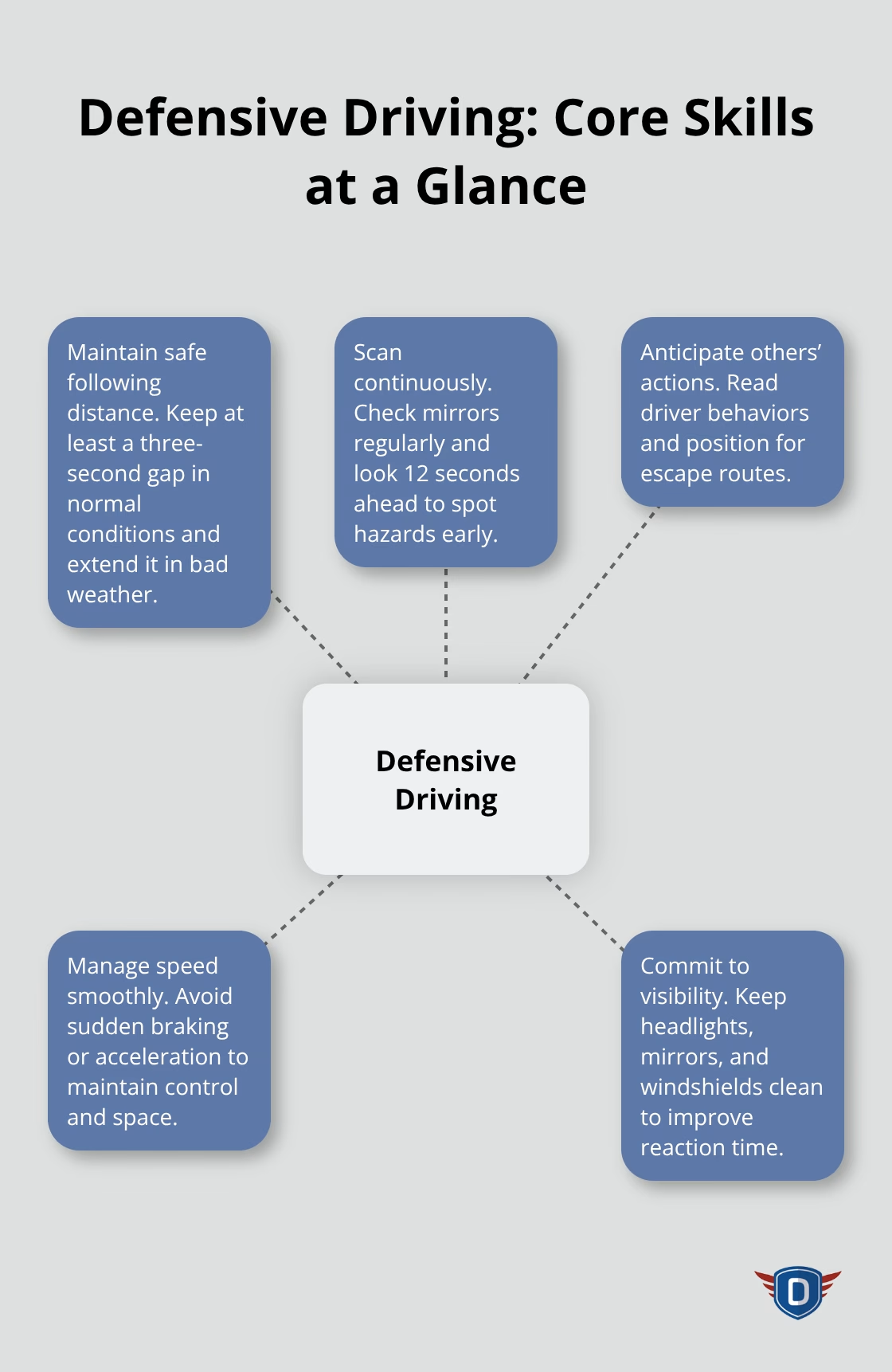
Anticipate Other Drivers’ Actions
Aggressive drivers telegraph their intentions through specific behaviors: rapid lane changes without signals, tailgating, and sudden acceleration patterns. The American Automobile Association identifies these warning signs as precursors to dangerous maneuvers in 73% of road rage incidents. Watch for vehicles that weave between lanes, drivers who brake erratically, and cars that ignore traffic signals. Position your vehicle to maximize escape routes when you spot these behaviors and maintain extra following distance while you avoid the temptation to engage with aggressive drivers through eye contact or gestures.
These fundamental techniques prepare you to handle the various road hazards and challenging situations that await every driver on today’s roads.
Common Road Hazards and How to Handle Them
Dealing with Aggressive and Distracted Drivers
Aggressive drivers create unpredictable situations that demand immediate defensive responses. The National Highway Traffic Safety Administration reports that aggressive driving contributes to 29% of fatal crashes, with tailgating as the most dangerous behavior. When you encounter an aggressive driver, change lanes safely to let them pass rather than match their speed or block their path. Distracted drivers pose an equally serious threat, with texting while driving causing drivers to travel the length of a football field blind at 55 mph according to NHTSA data.
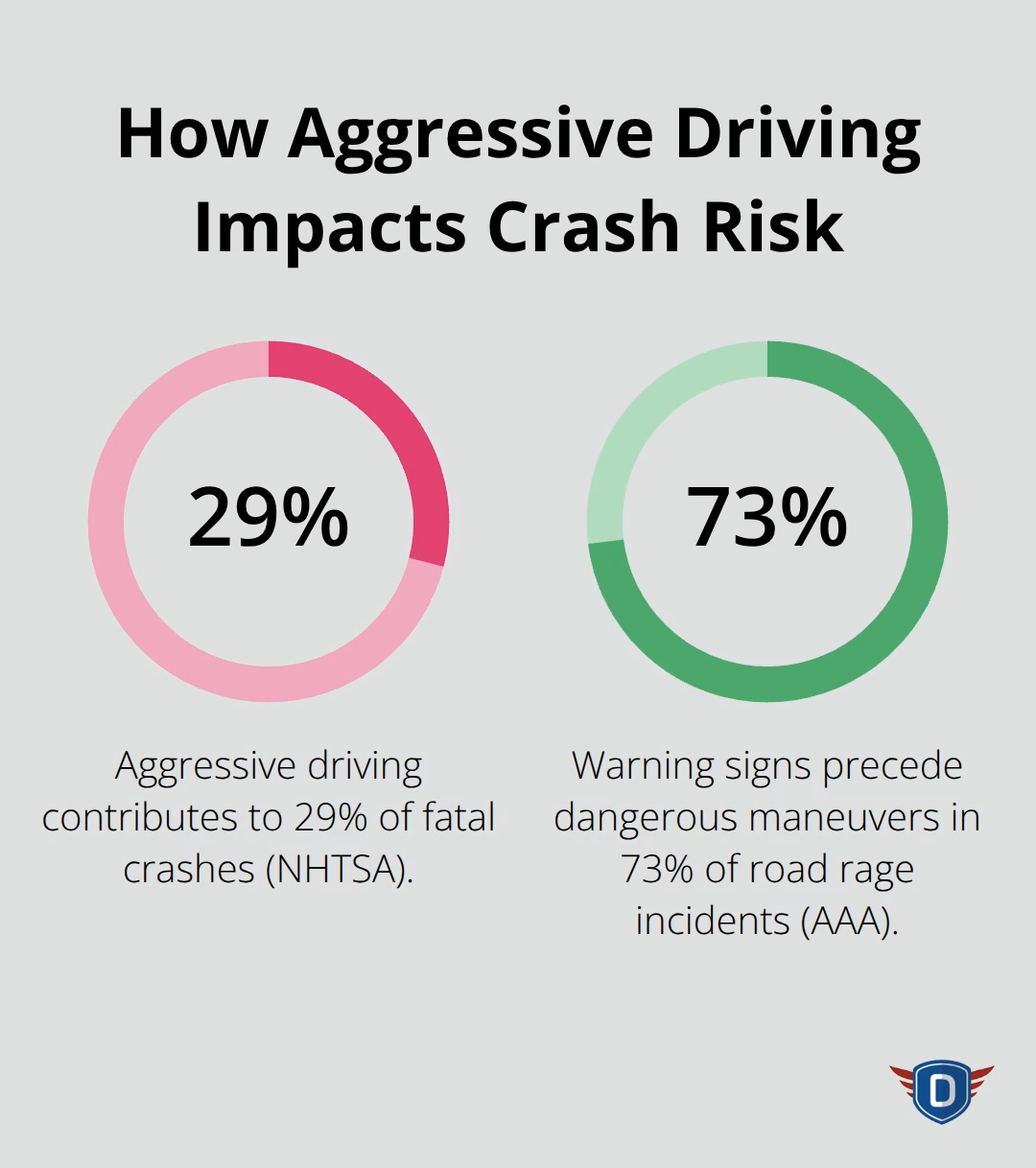
Watch for vehicles that drift between lanes, brake inconsistently, or respond slowly to traffic signals. Position yourself where you have multiple escape routes and avoid driving in their blind spots for extended periods. These drivers often exhibit erratic patterns that telegraph their next dangerous move. Regularly checking mirrors and blind spots helps increase your awareness of potential hazards and aggressive drivers.
Navigating Weather-Related Challenges
Rain reduces tire traction by 30% on average pavement, while snow and ice can decrease it by up to 90% according to the Federal Highway Administration. Reduce your speed by 25% in light rain and 50% in heavy precipitation or snow conditions. Increase your following distance to eight seconds minimum when roads are wet and twelve seconds on ice.
Black ice forms most commonly on bridges, overpasses, and shaded areas when temperatures hover around 32 degrees Fahrenheit. Test your brakes gently when you suspect icy conditions and avoid sudden steering movements that can cause skids. Driving safely in wet conditions requires reducing speed, increasing following distance, and applying smooth driving techniques to maintain control.
Managing Construction Zones and Emergency Vehicles
Construction zone crashes kill approximately 700 people annually, with 85% of fatalities involving motorists rather than workers according to the Federal Highway Administration. Merge early when you see construction signs rather than wait until the last moment, which causes dangerous bottlenecks. Reduce speed immediately when you enter work zones, as many states double fines for speeding violations in these areas.
When emergency vehicles approach with flashing lights, move over to an adjacent lane if possible or reduce speed significantly if lane changes are unsafe. All 50 states have Move Over laws that require drivers to change lanes or slow down for stopped emergency vehicles (with violations carrying fines up to $2,000 in some jurisdictions). Maintaining space around your vehicle and having escape routes becomes crucial when facing these unique driving challenges.
Advanced Safety Strategies for Different Driving Conditions
Highway and Freeway Defensive Techniques
Highway crashes at speeds above 55 mph result in fatalities 85% more often than city accidents according to the National Highway Traffic Safety Administration. Drivers must maintain a four-second following distance minimum at highway speeds and increase this to six seconds when traffic exceeds 70 mph. Position your vehicle in the center or right lanes rather than the left passing lane to maximize escape routes when aggressive drivers approach.
Check blind spots twice before you change lanes at high speeds, as vehicles can close distance gaps 40% faster than drivers typically anticipate. Use your mirrors every 8-10 seconds and scan ahead at least 15 seconds to identify potential hazards like disabled vehicles or sudden traffic slowdowns. Highway speeds amplify the consequences of every decision you make behind the wheel.
City and Urban Driving Safety Measures
Urban environments present the opposite challenge with intersection crashes that resulted in 11,843 fatalities in 2023. Come to complete stops at red lights and stop signs because rolling stops contribute to 30% of intersection accidents. Scan intersections completely before you proceed on green lights, as 2.3 seconds pass before most drivers react to cross-traffic violations.
Expect pedestrians and cyclists to appear suddenly, particularly during morning and evening rush hours when visibility drops. Urban traffic patterns create constant hazards that demand continuous attention and quick decision-making from every driver on the road.
Night and Low Visibility Driving Precautions
Night conditions multiply crash risks by three times compared to daylight conditions, with reduced depth perception and 90% decreased peripheral vision that creates dangerous blind zones. Clean your headlights monthly and replace them when output drops below 80% effectiveness, as dirty or dim lights reduce your visible range from 500 feet to 200 feet.
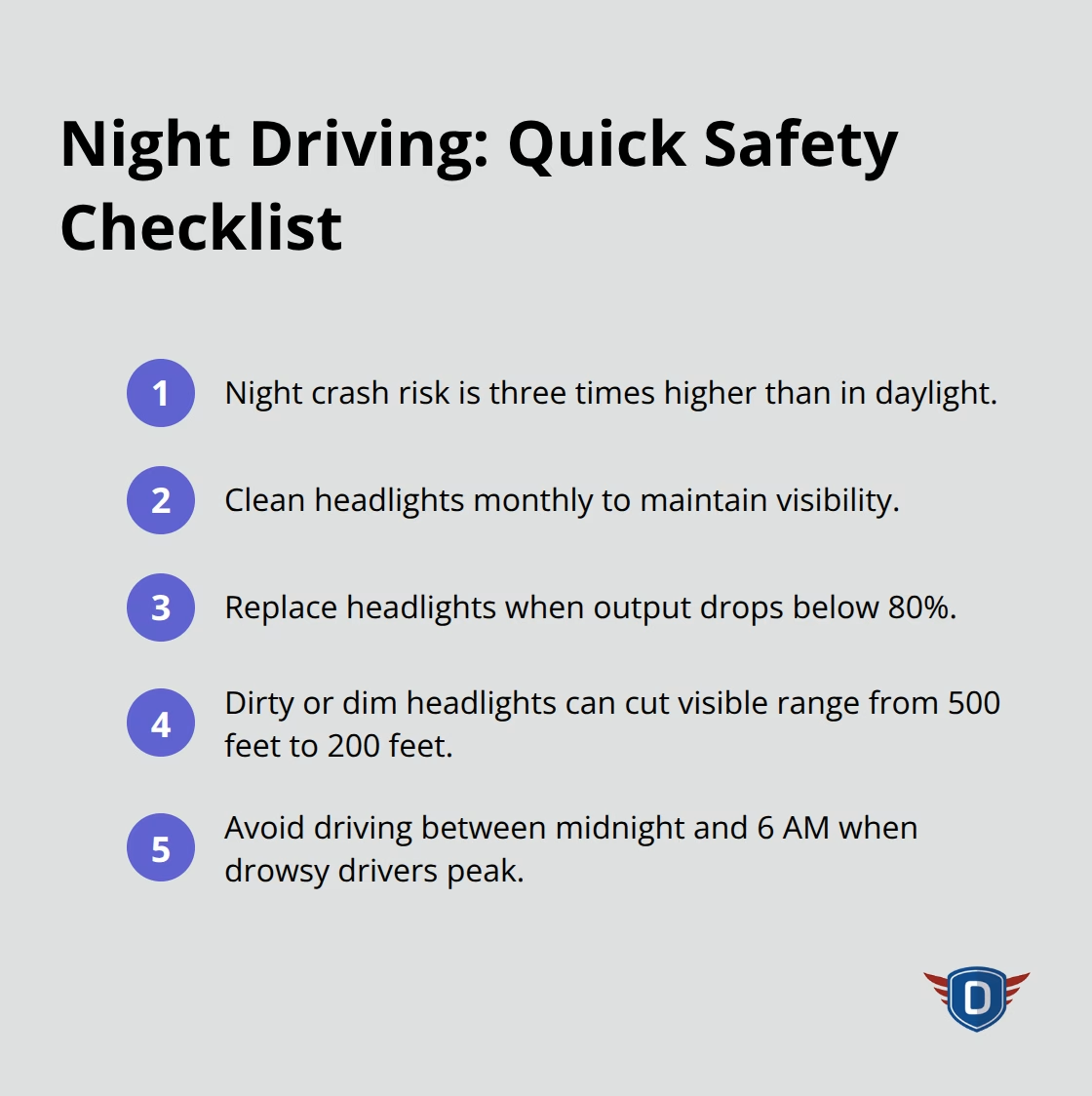
Avoid travel between midnight and 6 AM when drowsy drivers peak, causing 100,000 crashes annually according to the National Sleep Foundation. Darkness eliminates many visual cues that help drivers judge speed and distance accurately during daylight hours.
Final Thoughts
These defensive driving safety tips protect you from the 94% of crashes that human error causes when you apply them consistently. The three-second rule, continuous road scanning, and hazard anticipation create a foundation that adapts to weather conditions, aggressive drivers, and different road environments. Professional instruction accelerates your skill development and identifies technique gaps that self-study methods miss.
We at floridanewdriver.com offer driver education programs with certified instructors who teach these life-saving techniques through personalized guidance. Our students develop technical skills needed to pass their requirements and the defensive mindset that prevents accidents throughout their careers. Formal training provides structured learning that builds confidence and competence behind the wheel.
Statistics show that drivers who complete formal defensive driving training reduce their crash risk by 35% compared to those who rely solely on basic licensing requirements. Your commitment to skill improvement protects your life and the lives of every person who shares the road with you. Advanced techniques become second nature when you practice them regularly and receive proper instruction.



